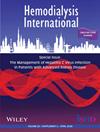The relationship between skeletal muscle mass and exercise capacity in patients undergoing hemodialysis: An exploratory secondary-analysis
Abstract
Background
Protein-energy wasting is commonly observed in patients undergoing hemodialysis, leading to reduced muscle mass and, in severe cases, sarcopenia, which significantly impacts the patients' quality of life and clinical outcomes. Exercise interventions are frequently employed to address muscle loss in these patients. However, the relationship between exercise capacity and skeletal muscle mass in this context remains uncertain. In this study, researchers conducted a series of body composition analysis and exercise capacity test to explore the relationship between exercise capacity and skeletal muscle mass.
Methods
This study recruited 32 patients undergoing hemodialysis and analyzed their demographic and clinical parameters. To assess aerobic exercise capacity, the incremental shuttle walking test (ISWT) was conducted, while the handgrip strength test was used to evaluate muscle strength. The patients' body compositions were assessed using the Fresenius Body Composition Monitor, and the appendicular skeletal muscle was scanned using a GE Healthcare Lunar iDXA scanner. Three sequential linear models were employed to model the relationship between ISWT and skeletal muscle mass. Model 1 regressed ISWT against gender and age; Model 2 added handgrip strength, fat tissue index, and Davies comorbidity scores as additional predictors; and Model 3 further included the appendicular skeletal muscle index (appendicular skeletal muscle/height).
Findings
After controlling for age and gender (Model 1: R2 = 0.373), and subsequently including handgrip strength, fat tissue index, and Davies comorbidity score effects (Model 2: R2 = 0.581), the impact of appendicular skeletal muscle on ISWT was found to be non-significant (Model 3: R2 = 0.600).
Conclusion
There was no significant correlation observed between exercise capacity and skeletal muscle mass in patients undergoing hemodialysis, indicating the factors influencing exercise capacity in this patient population are complex and that increasing skeletal muscle mass may not necessarily involve solely addressing the improvement of exercise capacity.

 求助内容:
求助内容: 应助结果提醒方式:
应助结果提醒方式:


